Epidemics and Genealogical Research
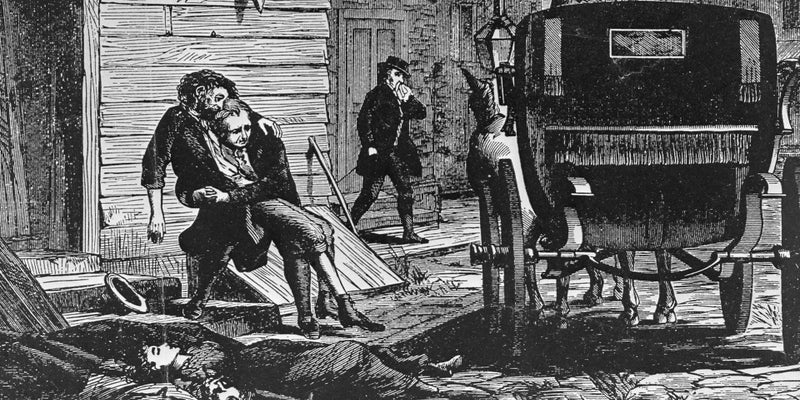
“Philadelphia 11th october 1793 11 OClock A.M. “The fever from all that I can learn is more fatal than ever, yesterday a vast number of burials – I do not expect any abatement of the fever before we have rain and high winds – The day before yesterday we were witness to what appears to me Shocking – a Coffin was brought to the entrance of Welsh’s alley, where it stayed sometime for the man to die before he was put into the Coffin, Such hurry must burry many alive.”
The role of disease-causing microbes in human history has long been studied. When conducting genealogical research, however, knowledge of disease becomes just as important. Disease could be the reason why you can’t find an ancestor somewhere, or why long-residing families suddenly relocated, or why an ancestor may have remarried. But it also has wider genealogical ramifications. Disease affected entire communities. It was also influenced by geography, warfare, and weather. Given its great importance, knowledge of epidemic disease is an integral part of genealogical research.
For genealogical purposes, the focus will be on European settlers in North America, specifically within the original thirteen colonies and later United States.
History of Epidemics in Thirteen Colonies and United States
The first known epidemic was in Plymouth Colony. It was believed to have been smallpox and was recorded by William Bradford in his book Of Plimoth Plantation. On page 197 (Fig. 1) he wrote that in 1633, “It pleased ye Lord to visite them this year with an infectious fevoure, of which many fell very sicke, and upward of 20. persons dyed, men and women, besids children, and sundry of them of their anciente friends which had lived in Holand; . . . “

The first written record of a measles epidemic in the colonies is from the journal of John Hull, Mint-Master and Treasurer of Massachusetts Bay Colony, November 13, 1657:
This summer, in the months of September and October, [in] the town of Boston . . . the disease of measles went through the town : scare any house escaped ; only through the goodness of God, scarce any died of it. The like soon after befell most of the towns hereabouts.
Diaries of John Hull, Mint-master and Treasurer of the Colony of Massachusetts Bay. From the original manuscript in the collection of the American Antiquarian Society. Boston: John Wilson, 1857.
You can see by reading through this chronology of epidemics in North America that our ancestors were no strangers to disease and why it’s important to know when and where epidemics occurred. They were commonplace and could be localized in a community or wide-spread throughout a county or region. You would likely find one or more ancestors who died during outbreaks, but it may not be obvious which records would reveal this or where such records would be located.
Sources of Illness or Death Information
Depending on the time and place, various resources may be available to help you identify epidemics and document deaths, and these are discussed below.
Letters
Letters between family members can provide intimate and personal experiences and reflections of those living through epidemic and what it was like to do so. During an outbreak of cholera in 1832 S. F. Kimball of Middleburgh, New York wrote to his mother Rachel that “this dreadful destroyer has made its appearance in the Eastern part of the town of Schoharie adjoining Duanesburgh & Bern . . . up to Sunday there had been 11 cases & 4 deaths . . . the inhabitants of Schoharie Village are very much alarmed, as the disease appears to be spreading in a direction towards them . . . the place where the disease broke out was about 8 miles, so that it has already spread 5 miles in that direction.”
A doctor at Camp Devens in Boston during the 1918 influenza pandemic wrote that “the little town of Ayer [43 miles northwest of Boston] is a sight. It takes special trains to carry away the dead. For several days there were no coffins and the bodies piled up something fierce, we used to go down to the morgue . . . and look at the boys laid out in long rows. It beats any sight they ever had in France after a battle.”
Reports
Reports from government and health officials often provide information pertaining to epidemics that may or may not include names of victims. The Yellow Fever epidemic of 1793 created panic in Philadelphia, then the national capital, causing 17,000 people, including President Washington and other members of the federal government, to flee to the countryside. Two reports from the papers of Secretary of War Henry Knox described the fear and terror of the time (Fig. 2):
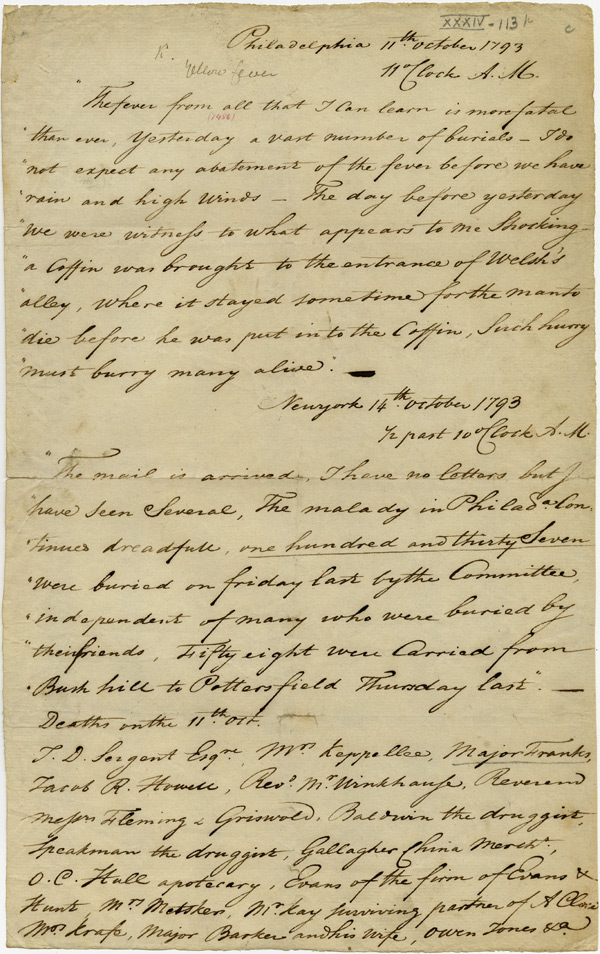
“Philadelphia 11th october 1793 11 OClock A.M. “The fever from all that I can learn is more fatal than ever, yesterday a vast number of burials – I do not expect any abatement of the fever before we have rain and high winds – The day before yesterday we were witness to what appears to me Shocking – a Coffin was brought to the entrance of Welsh’s alley, where it stayed sometime for the man to die before he was put into the Coffin, Such hurry must burry many alive.”
“New York 14th October 1793 ½ past 10 OClock A.M. “The mail is arrived, I have no letters but I have seen Several, The malady in Philada continues dreadful, one hundred and thirty Seven were buried on friday last by the Committee independent of many who were buried by their friends, Fifty eight were Carried from Bush hill to Pottersfield Thursday last.—”Deaths on the 11th oct. T. D. Sergent Esqre. Mrs. Keppellee, Major Franks, Jacob R. Howell, Revd. Mr. Winkhouse, Reverend Messrs Fleming & Griswold, Baldwin the druggist, Speakman the druggist, Gallagher China Mercht, O.C. Hull apotecary, Evans of the firm of Evans & Hunts, Mrs. Metsker, Mr. Kay surviving partner of A Clare Mrs. Krafe, Major Barker and his wife, Owen Jones &c.”
Diaries

Wilmer’s diary, August 1834.
Diaries can also contain information about sickness in a locality. In her diary, Rachel Wilmer, travelling the Erie Canal in 1834, wrote that “one Passenger was taken with the Cholera and left on the road I was taken very sick on the way but affraid thay would think it the Cho. – I did not complain but with the assistance of some opium I got better. 14 of Aug. we arrived at about 4 o’clock and I thank our heavenly father I am better 15 Our Old Friend D. called finding the Cholera bad at Buffalo he hurried on 17 of Au.” (Fig. 3)
A digitized copy of pages from the 18th-century diary of Rev. Ebenezer Storer during a period of smallpox in Boston shows an April 1764 entry that includes a prayer Storer wrote weeks after arranging to have his own children inoculated. In the prayer, he gives thanks for the recovery of family members from the disease.
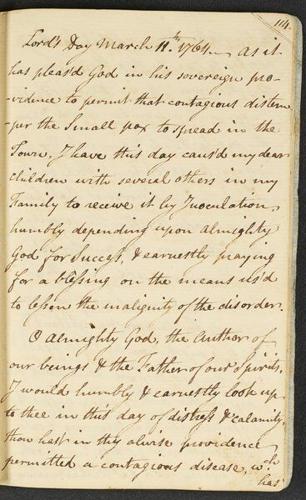
Storer’s diary, April 1764.
Newspapers
Newspapers can be an excellent resource for researching epidemics. They may have articles about the epidemic showing lists of disease victims that may include age and/or place of residence that are separate for obituaries and/or death notices, so be sure to check for both possibilities. There are many searchable free and subscription newspaper databases available. Grapevine Library subscribes to Newspapers.com and NewspaperArchive. For free resources, check out Chronicling America and the newspaper portal The Ancestor Hunt. Also check for newspapers in your specific locality that may be locally digitized. Some good search terms to use include “[localityname],” “epidemic,” “[name of disease],” and the year(s).
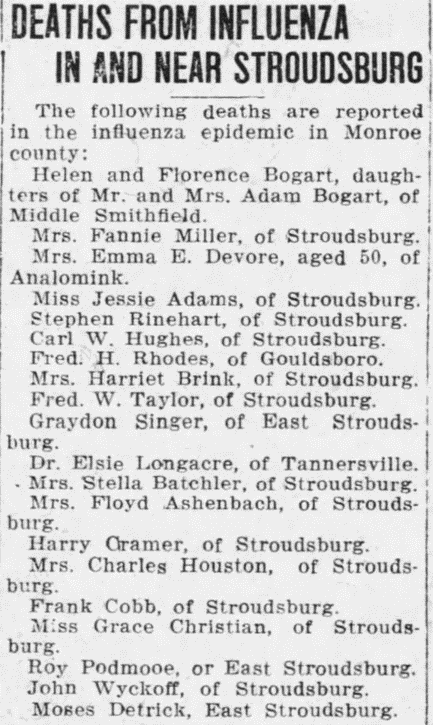
the Allentown, Pennsylvania
Morning Call newspaper,
October 9, 1918.
This list from The Morning Call newspaper in Allentown, Pennsylvania (Fig. 5) is typical of deaths reported in newspapers at the height of the 1918 influenza pandemic. The person’s age and residence may also be given. Some lists may be relatively short, while others are tragically long.
Immunity Cards
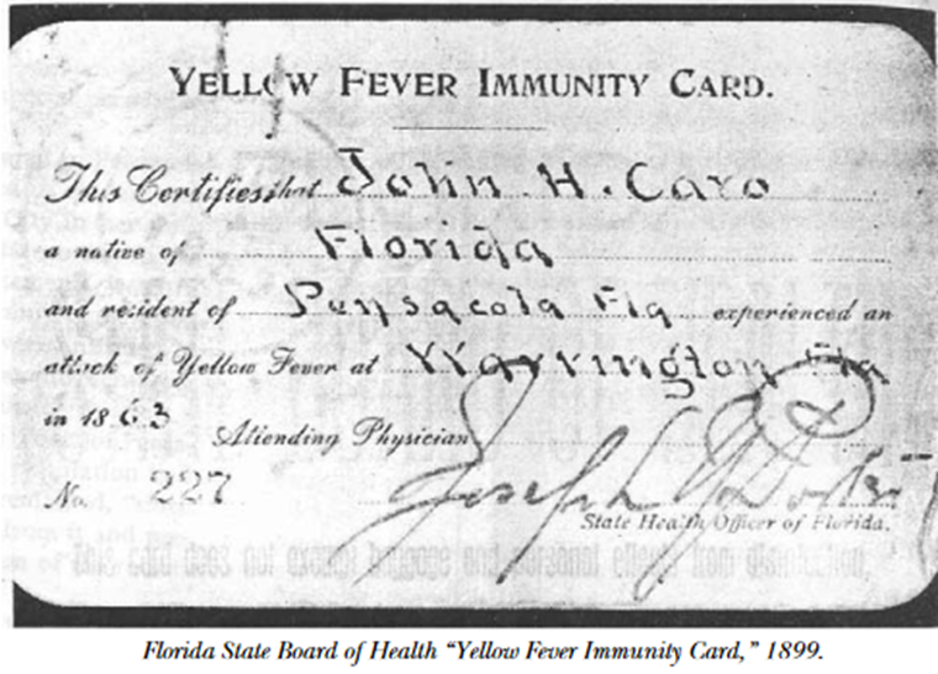
immunity card.
During Yellow Fever epidemics of the late 19th century-South (1875-1905), one of the ways that local governments attempted to mitigate the spread of disease was by imposing “shotgun quarantines.” To the extent travelers were in some way inspected, they could pass through by demonstrating immunity by having had the disease in the past, or by getting or forging a doctor’s note. To standardize the process, “official” immunity cards were issued by state boards of health in an effort to aid citizens (Figs. 6a and 6b), but instead they caused innumerable hardships for the mobility of those unaffected by the disease. The only known cards were issued by the Florida State Board of Health beginning in 1897 and would have been kept by the individual.

County Histories
County histories usually discuss health as part of their history, often in relation to the area’s climate. For example, Chapter 14 of Hewson L. Peeke’s A Standard History of Erie County Ohio (1916) describes three cholera epidemics between 1849 and 1855 and lists those known to have died from it. Other histories, such as History of Cook County Illinois may include a brief paragraph or a few pages describing an outbreak with or without naming the afflicted. Check to see if your county of interest has a published history. It’s important to remember the importance of historical context while doing genealogical research, as our ancestors acted and reacted in the real world around them and did not live in a social vacuum.
Special Publications
Special publications generated specifically to relate incidences of epidemics can also be genealogically helpful. Peter Murtough’s Condensed History of the Great Yellow Fever Epidemic of 1878 gives personal sketches, a list of cities and towns affected by the disease and names of fever victims in Memphis, Tennessee (Fig. 7). Memphis had six major Yellow Fever epidemics:
- 1828 First Yellow Fever epidemic – 650 cases – 150 deaths
- 1855 Second Yellow Fever epidemic – 1250 – 220 deaths
- 1867 Third Yellow Fever epidemic – 2500 cases – 550 deaths
- 1873 Fourth Yellow Fever epidemic – 5000 cases – 2000 deaths
- 1878 Fifth Yellow Fever epidemic – 17000 cases – 5000+ deaths
- 1879 Sixth Yellow Fever epidemic – 2000 cases – 600 deaths
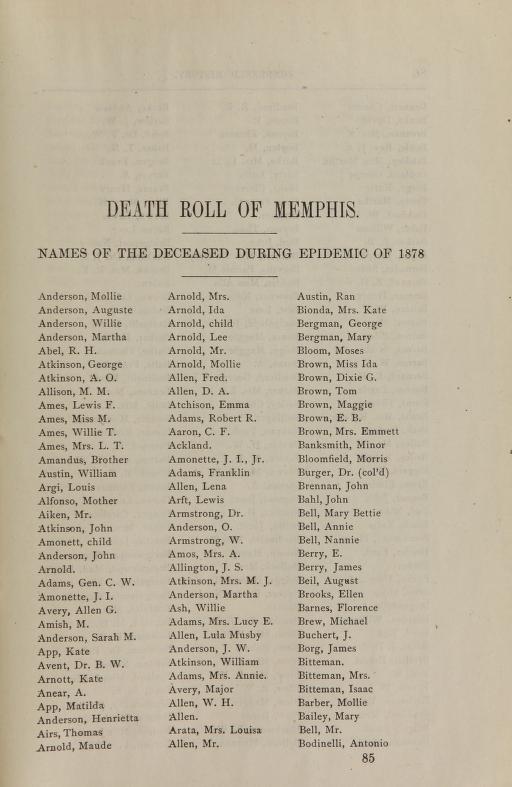
the Great Yellow Fever Epidemic of 1878
There is even a Yellow Fever Martyrs Church & Museum in Holly Springs, Mississippi you can visit. Explore their web site here.
Another special report is The Epidemic Summer. List of Interments in All the Cemeteries of New Orleans, from the First of May to the First of November, 1853 It gives names, ages, birthplaces, cause of death, and burial dates and places (Fig. 8).
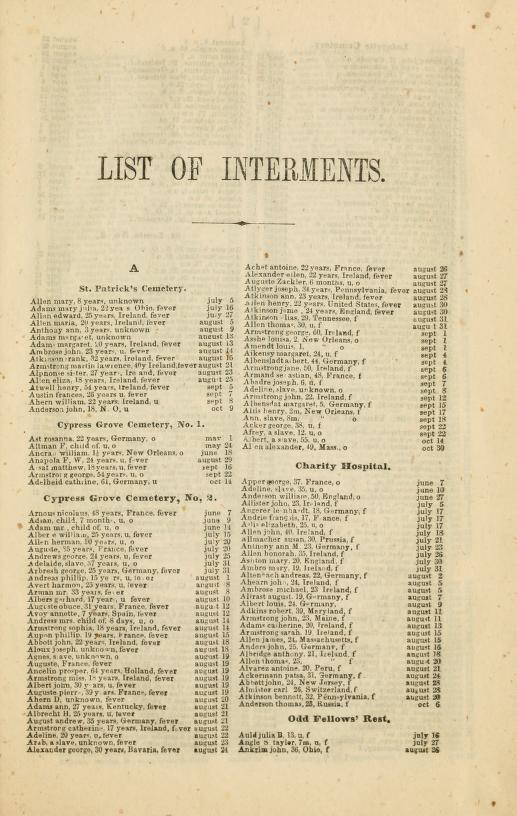
Cemeteries
Some cemeteries commemorate the victims of epidemics. There is a plaque listing the known names of 1862 Yellow Fever victims buried in the public burial ground at Oakdale Cemetery in Wilmington, North Carolina (Fig. 9). It was installed as part of an Eagle Scout 232 project in 2017 to identify as many affected individuals as possible.
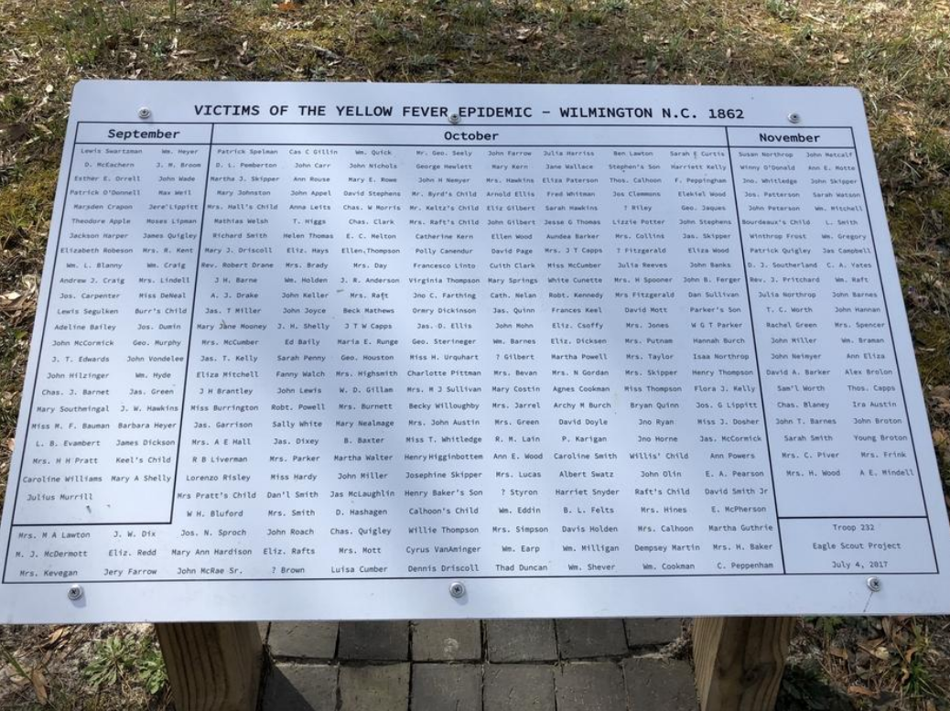
Cemetery, Wilmington, North Carolina.
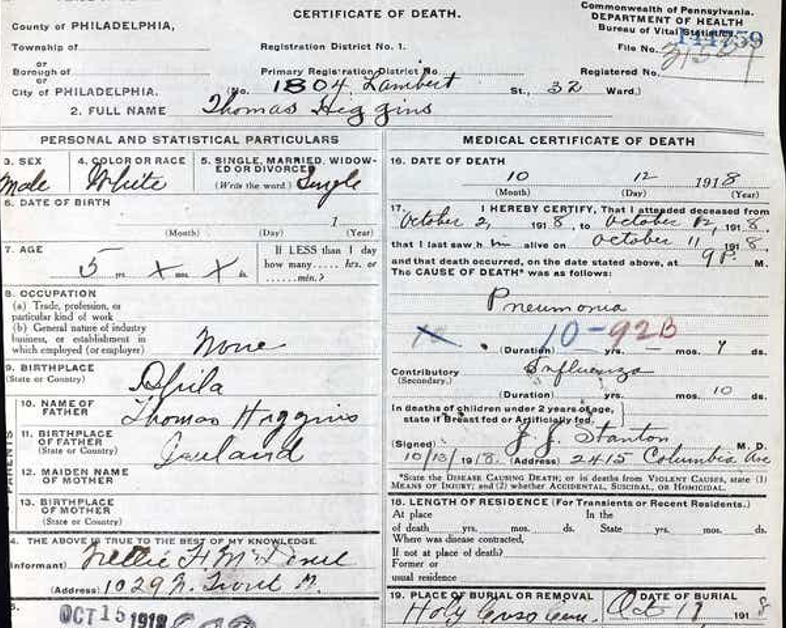
Higgins. Note the 1909 ILCD code “10-920”
indicating pneumonia, contributed by influenza.
Death Records and Certificates
Before death certificates, some counties, towns, and cities recorded deaths in registers and included the cause of death, if known. Some registers have been digitized, and it’s worth checking on-line digital collections to see if registers or certificates are available for your locality. A larger-than-usual number of deaths from the same disease may indicate an epidemic even if the occurrence wasn’t labeled as one. Once standardized death certificates became the norm, the cause of death as well contributory factors were included. In some cases you might find a classification number written in the “cause of death” area. This came from the International List of Causes of Death which was first published in 1893 and has been updated and revised over time, becoming the International Classification of Diseases (ICD) in 1948. In Fig. 10, you can see “10-92B” on the right side of this 1918 certificate, which meant “Influenza, Pneumonia (type not stated)” in the 1909 revision of the ILCD. This site lists all of the ILCD and ICD code revisions from 1893-1990.
Theses, Dissertations, Scholarly Articles
Academic theses and dissertations, published or not, can also be great sources of epidemic information relating to a stricken community. They included bibliographies that provide further research opportunities. Two examples are Sara Kathryn Dawson, “The 1833 Cholera Epidemic in Kentucky: A Study of Devastation and Recovery,” M.A. Thesis, University of Kentucky, 1994, and Jo Ann Carrigan, ”The Saffron Scourge: A History of Yellow Fever in Louisiana, 1796-1905,” Louisiana State University and Agricultural & Mechanical College, 1961. Carrigan’s thesis was published in paperback in 2015 under the same title.
Also, don’t be afraid to try search terms on Google Scholar. Some articles can be read for free. If not, take advantage of your library’s interlibrary loan program to request a copy.
More Ways To Identify Outbreaks
We’ve looked at several ways to learn about and obtain historical and genealogical information relating to epidemics during the American colonial and federal eras. Some additional resources you can check for include online exhibits by libraries and archives as well as genealogy magazines such as Family Tree Magazine and those of genealogical and historical societies around the country. The best way to locate genealogical periodical articles is to use the Periodical Source Index (PERSI) at the Allen County Genealogy Center web site. Click on “Article Title Keyword”, then enter terms such as “epidemic”, “yellow fever”, “smallpox”, etc.
Discovering the effects of epidemics on our ancestors is an integral part of learning about the social fabric of their times. It should be incorporated into everyone’s family history research, and by using these tools you will find many resources to help you do just that.





Recent Comments